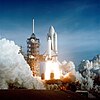STS-39
| Mission emblem | |||
|---|---|---|---|

|
|||
| Mission dates | |||
| Mission: | STS-39 | ||
| COSPAR-ID : | 1991-031A | ||
| Crew: | 7th | ||
| Begin: | April 28, 1991, 11:33:14 UTC | ||
| Starting place: | Kennedy Space Center , LC-39A | ||
| Landing: | May 6, 1991, 18:55:35 UTC | ||
| Landing place: | Kennedy Space Center, Lane 15 | ||
| Flight duration: | 8d 7h 22m 23s | ||
| Earth orbits: | 140 | ||
| Rotation time : | 89.4 min | ||
| Orbit inclination : | 56.9 ° | ||
| Apogee : | 263 km | ||
| Perigee : | 249 km | ||
| Covered track: | 5.6 million km | ||
| Team photo | |||
 v. l. No. Charles Veach, Gregory Harbaugh, Donald McMonagle, Michael Coats, Blaine Hammond, Richard Hieb, Guion Bluford |
|||
| ◄ Before / After ► | |||
|
|||
STS-39 ( english S pace T ransportation S ystem) is a mission designation for the US Space Shuttle Discovery (OV-103) of NASA . The launch took place on April 28, 1991. It was the 40th space shuttle mission and the twelfth flight of the space shuttle Discovery.
team
- Michael Coats (3rd space flight), commander
- Blaine Hammond (1st spaceflight), pilot
- Guion Bluford (3rd space flight), mission specialist
- Gregory Harbaugh (1st spaceflight), mission specialist
- Richard Hieb (1st space flight), mission specialist
- Donald McMonagle (1st spaceflight), mission specialist
- Charles Veach (1st spaceflight), mission specialist
Mission overview
The launch was originally scheduled for March 9th. Three weeks earlier, just a few days after the Discovery rolled to the launch pad, workers discovered fine cracks on the hinged hatches where the fuel lines from the outer tank flow into the orbiter. It was therefore decided to bring the shuttle back to the construction hall. The connections have been replaced and reinforced by those of the Columbia shuttle . On April 1st, the shuttle returned to the launch pad, the launch was scheduled for April 23rd. However, during the refueling of the main tank, a sensor showed unusual values. The sensor and its wiring have been replaced and tested. The start date has been postponed to April 28th. The takeoff weight was 112,207 kg.
The mission was carried out for the US Department of Defense . The published payload included: Air Force Program 675 (AFP675) , Infrared Background Signature Survey (IBSS) with Critical Ionization Velocity (CIV) , Chemical Release Observation (CRO) and Shuttle Pallet Satellite-II (SPAS-II) experiments, as well Space Test Payload-1 (STP-1) . The payload classified as secret contained a multi-purpose release canister (MPEC) . Also on board were: Radiation Monitoring Equipment III (RME III) and Cloud Logic to Optimize Use of Defense Systems-IA (CLOUDS-I) .
STS-39 was the Department of Defense ( DoD )’s first non-secret shuttle mission . There were several shuttle flights for the DoD before, but these had been secret, no information about the payload, the purpose or success of the mission and its experiments was published. Only the MPEC experiment was classified as secret during this mission .
STS-39 investigates the southern northern lights
The team was divided into two teams in order to be able to work around the clock. Among other activities, the atmosphere was examined and experiments were carried out with the engines. As part of these experiments, five smaller satellites were deployed, one of which was recaptured.
The Remote Manipulator System arm in the shuttle's payload bay was used to deploy the Shuttle Pallet Satellite-II (SPAS-II) ; an IBSS module was mounted on this. Among other things, this satellite investigated the discovery of flight maneuvers such as the Malarkey Milkshake . The dispatch of the IBSS was postponed one day, to the fourth day of the flight, as the completion of the CIRRIS (Cryogenic Infrared Radiance Instrumentation for Shuttle) experiment was awaited. This experiment observed polar lights and similar atmospheric phenomena, but used up its supply of liquid helium faster than expected.
As usual, the crew also had to cope with unexpected tasks. Two tape drives went out of service after four hours of use and could not be repaired. Their task was to record the observations made by the instruments of the AFP-675 experiment. In two hours of work, the astronauts had to lay new cables and improvise a Ku-band antenna in order to be able to transmit the data directly to the ground station.
The high orbital inclination of 57 degrees to the equator made it possible to fly over and examine large parts of the land mass. Environmental resources were recorded and problem areas were documented.
The landing took place on May 6 at 14:55:35 at Kennedy Space Center, Florida. The coasting distance was 9,235 feet and the coasting time was 56 seconds. The landing was relocated to Florida, as the actually planned landing site in California ( Edwards AFB ) was too windy. The landing weight was 95,940 kg.
See also
Web links
- NASA Mission overview (English)
- Video summary with comments of the crew (English)
- STS-39 in the Encyclopedia Astronautica (English)
- Michael Cassutt: Secret Space Shuttles (English)
